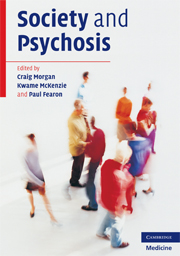Book contents
- Frontmatter
- Contents
- Contributors
- Acknowledgements
- 1 Introduction
- 2 Climate change in psychiatry: periodic fluctuations or terminal trend?
- Part I Theoretical and conceptual foundations
- 3 Social science, psychiatry and psychosis
- 4 Conceptualising the social world
- 5 Genes and the social environment
- Part II Social factors and the onset of psychosis
- Part III Social factors and the outcome of psychosis
- Part IV Models and conclusions
- Index
- References
5 - Genes and the social environment
from Part I - Theoretical and conceptual foundations
Published online by Cambridge University Press: 07 December 2009
- Frontmatter
- Contents
- Contributors
- Acknowledgements
- 1 Introduction
- 2 Climate change in psychiatry: periodic fluctuations or terminal trend?
- Part I Theoretical and conceptual foundations
- 3 Social science, psychiatry and psychosis
- 4 Conceptualising the social world
- 5 Genes and the social environment
- Part II Social factors and the onset of psychosis
- Part III Social factors and the outcome of psychosis
- Part IV Models and conclusions
- Index
- References
Summary
Introduction
Understanding the contributions of both genes and environments is essential to unravelling the aetiology of psychosis. In this chapter, we consider how genes might interact with aspects of the social environment in the genesis of psychiatric disorders. We describe evidence for such interactions from early adoption studies to recent investigations using modern molecular genetic techniques. We discuss the principal methodological issues of such research, and the need for clarification of the mechanisms of gene–environment interaction. Finally we consider the challenges that increasing knowledge of epigenetics will bring to the field.
History and overview of the field
Schizophrenia and other psychotic illnesses are undoubtedly highly heritable. For schizophrenia, the risk of the disorder in first-degree relatives is perhaps 5%, compared with 0.5% for the relatives of controls (Kendler and Diehl, 1993). Concordance rates for schizophrenia are 42–50% in monozygotic (identical) twins and 0–14% in dizygotic (fraternal) twins (Cardno and Murray, 2003); heritability estimates for most psychotic disorders hover around 80–85% (Cardno et al., 1999). Since concordance in monozygotic twins is not 100%, genes cannot be ‘sufficient’ causes for psychosis, though they may be ‘necessary’, and unaffected relatives may pass on an increased risk for disorder (Gottesman and Bertelsen, 1989). This high heritability does not rule out the importance of environments in the aetiology of psychosis, nor of gene–environment interactions; in fact, gene–environment interactions contribute to the heritability estimates produced by quantitative genetic studies (Moffitt et al., 2005).
Keywords
- Type
- Chapter
- Information
- Society and Psychosis , pp. 58 - 74Publisher: Cambridge University PressPrint publication year: 2008

